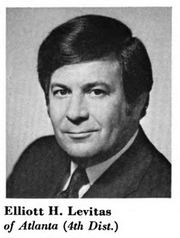Elliott H. Levitas
| Elliott H. Levitas | |
|---|---|
 | |
| Member of the U.S. House of Representatives from Georgia's 4th district | |
|
In office January 3, 1975 – January 3, 1985 | |
| Preceded by | Benjamin B. Blackburn |
| Succeeded by | Pat Swindall |
| Member of the Georgia House of Representatives | |
|
In office 1965–1974 | |
| Personal details | |
| Born |
Elliott Harris Levitas December 26, 1930 Atlanta, Georgia, USA |
| Nationality | American |
| Political party | Democratic |
| Residence | Atlanta, Georgia |
| Alma mater |
Henry W. Grady High School |
| Profession | Attorney |
| Religion | Judaism[1] |
Elliott Harris Levitas (born December 26, 1930) is a former U.S. Representative from Georgia's 4th congressional district.
Life and career
Born in Atlanta, Georgia, Levitas graduated in 1948 from Henry W. Grady High School there. He attended Emory University in Atlanta, where he was a member of the secret honor society D.V.S.
In 1956, he earned a Juris Doctor from the Emory University School of Law. A Rhodes scholar, he received a masters of law degree in 1958 from University of Oxford in England.
He conducted additional study in law at the University of Michigan from 1954 to 1955. He was admitted to the Georgia bar in 1955 and commenced practice in Atlanta. He was in the United States Air Force from 1955 to 1958. Levitas was a delegate to the 1964 Democratic National Convention in Atlantic City, New Jersey, which nominated the Lyndon B. Johnson/Hubert H. Humphrey ticket, the first Democratic slate to lose the electoral votes of Georgia since the Reconstruction era.
Levitas was elected to the Georgia House of Representatives in 1964 and served from 1965 to 1974. In his second term in the state House, he was one of thirty Democrats who voted for the Republican Howard Callaway, rather than the Democratic nominee, Lester Maddox, a segregationist from Atlanta, in the disputed 1966 gubernatorial race. The legislature, however, chose Maddox to resolve the deadlock though Callaway had led the balloting in the general election by some three thousand votes.[2]
Levitas was elected as a Democrat to the Ninety-fourth and to the four succeeding Congresses (January 3, 1975 – January 3, 1985). He was an unsuccessful candidate for reelection to the Ninety-ninth Congress in 1984. He resides in Atlanta.
Levitas represented mostly DeKalb County in the House. For four terms prior to his election, Benjamin B. Blackburn, a Republican, represented the area, which had a considerable population of suburban voters fleeing Atlanta's school desegregation efforts and the rise of African American political influence. In 1974, liberal whites in the Decatur and Emory University areas of the district and a few disgruntled Republicans elsewhere turned against Blackburn because of his support of President Richard Nixon in Watergate, thus enabling Levitas to get elected.
Levitas composed a mostly moderate record in the House, carefully balancing liberal and conservative interests. However, redistricting in the 1980s brought more Republican voters into Levitas's territory, and he succumbed in 1984 to Pat Swindall, who was later convicted of felony perjury charges. Most of Levitas's district at the time is now solidly Democratic territory, thanks to white flight turning many older DeKalb County suburbs into desirable residences for middle-class African Americans.
References
- ↑ Stone, Kurt F. "The Jews of Capitol Hill: A Compendium of Jewish Congressional Members, (2011). Pages 294–298. ISBN 9780810857315.
- ↑ Billy Hathorn, "The Frustration of Opportunity: Georgia Republicans and the Election of 1966", Atlanta History: A Journal of Georgia and the South, XXI (Winter 1987-1988), p. 47
External links
- Kilpatrick Townsend profile
- United States Congress. "Elliott H. Levitas (id: L000265)". Biographical Directory of the United States Congress.
| United States House of Representatives | ||
|---|---|---|
| Preceded by Benjamin B. Blackburn |
Member of the U.S. House of Representatives from Georgia's 4th congressional district January 3, 1975 – January 3, 1985 |
Succeeded by Pat Swindall |
![]() This article incorporates public domain material from the Biographical Directory of the United States Congress website http://bioguide.congress.gov.
This article incorporates public domain material from the Biographical Directory of the United States Congress website http://bioguide.congress.gov.